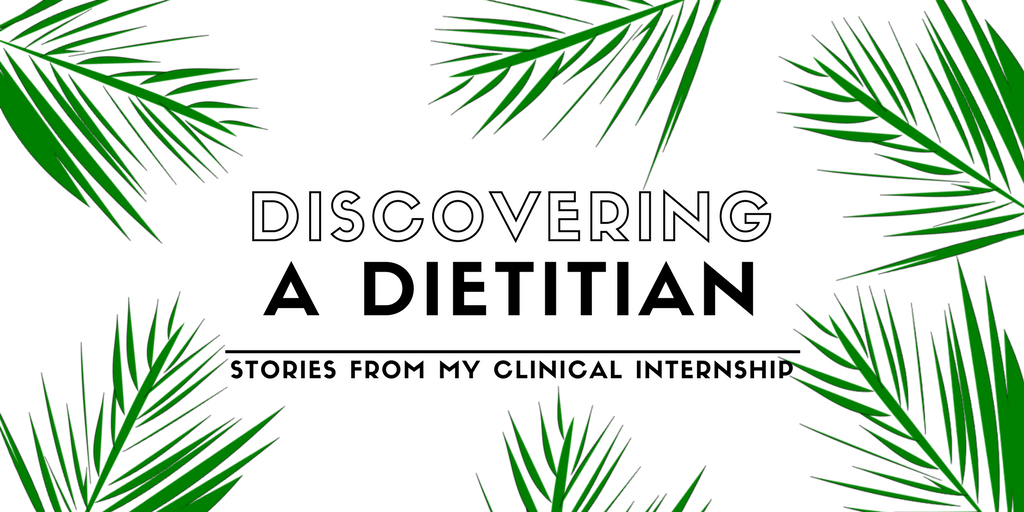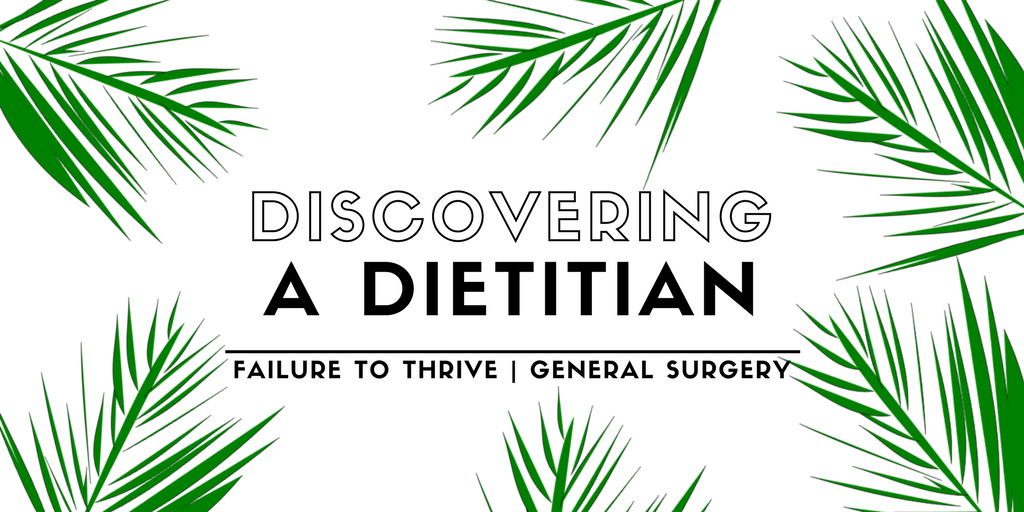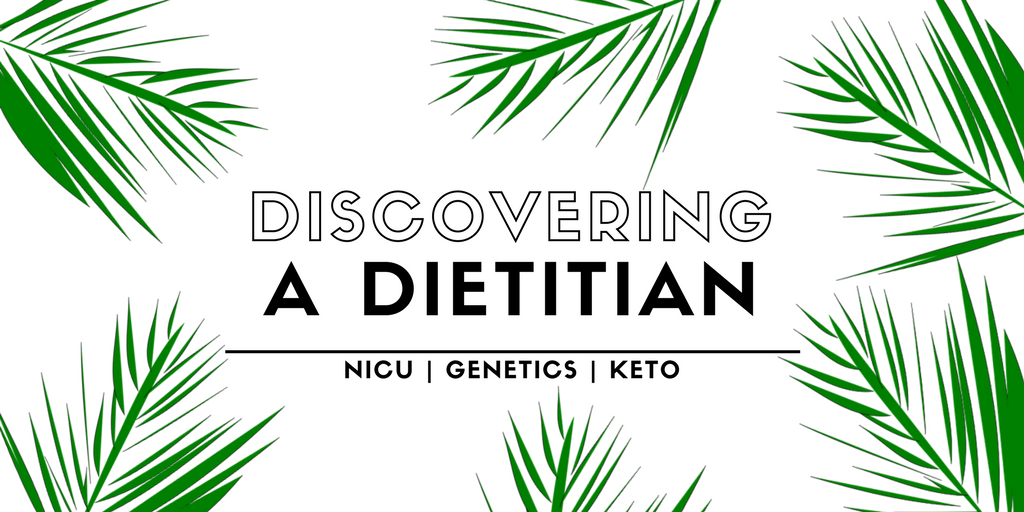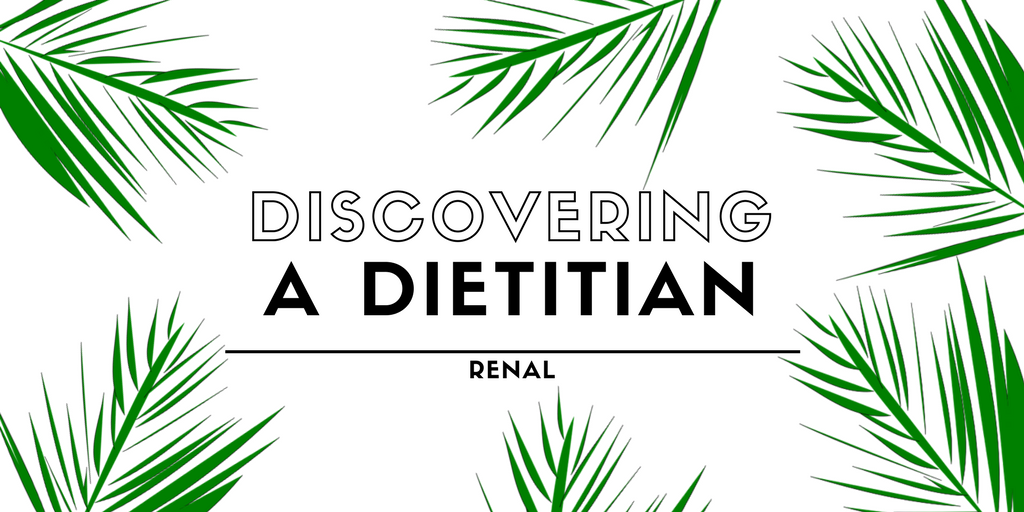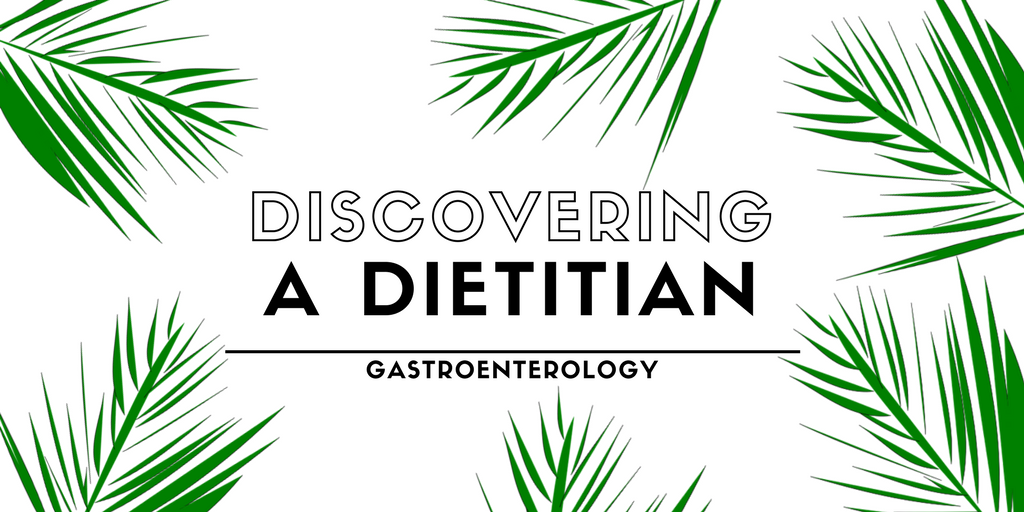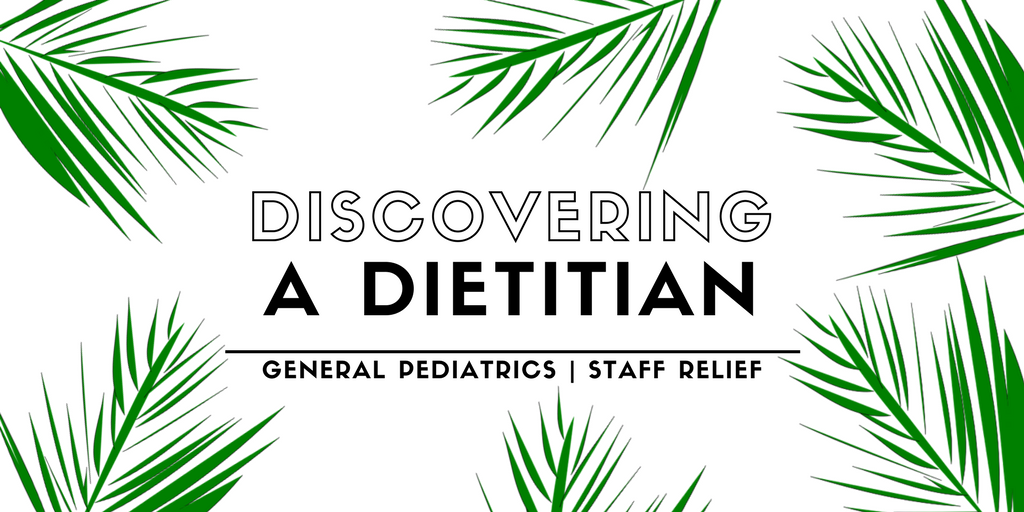|
Welcome to the series Discovering A Dietitian. The following posts are essentially a journal of the clinical portion of my dietetic internship. The purpose of these stories are to give you a little insight into the mysterious internship. I remember trying to research all I could about how the internships worked and what to expect, but there really isn't much out there regarding actual experiences. I also wanted to give you some perspective when it comes to the actual practice of clinical nutrition. We only learn so much in a classroom, the rest we get from practicing. Hopefully this real life account on clinical dietetics opens your eyes to what your future might hold.
Although I want this to be a helpful tool to guide you in your journey, I want you to remember these are MY experiences in MY internship. You may have a completely different experience, and that's okay. We can't plan for everything, and as I'll say several times throughout these posts, your internship is what you make it. You'll get out of it what you put into it. On all of these posts I would love to answer your questions and input if you too are completing a dietetic internship, feel free to comment!
0 Comments
Starting my dietetic internship (DI) in a clinical rotation at a children’s hospital may not be your typical internship experience, it was definitely not what I expected. I began in an outpatient clinic working with kids who have been diagnosed as failure to thrive (FTT). First off, I knew absolutely nothing about this area of dietetics, which comes to be a common theme throughout my internship. We hardly covered pediatrics in undergrad and when we did, we learned what healthy kids need, not how you get a child to grow through adverse life circumstances or when they simply won’t eat.
Despite feeling like I knew nothing about nutrition, I learned a lot about child nutrition in those first two weeks. My preceptor was very good about explaining the variety of formula’s they use in the clinic and showing me how to calculate the nutrients they provide. Additionally, she let me jump right in and begin taking diet histories, as that’s a consistency throughout all dietetics practices. During this time, I got my first taste of charting, I was terrible. I thought charting would be the one thing I could do because I always did well with writing notes in my undergrad. However, charting with medical software is not like writing an ADIME note for a case study. I did get lucky here though, the system used at my rotation was set up in an ADIME format for the most part, whereas some of the other interns in my program used a different set up. The hardest thing for me to grasp was how to be evaluative of the assessment data to explain why the interventions are necessary. They also don’t you the IDNT codes, which I was used to using for the diagnosis, interventions, and monitoring and evaluation. They did use IDNT diagnosis, just not the codes, and they seemed to just know what to use which was stressful as a beginner. Don’t worry though, this comes with time and practice, there is no need to stress, just learn from your experiences and move on. I did have a unique experience during these first two weeks because my preceptor is one of the RD’s who does blended diets for kids on tube feeds. She showed me the software they use and what the nutrient goals are then let me work with the ingredients to discover the cause and effect relationship, specific foods have on the nutrient contents. This experience really opened my eyes to blended diets, they aren’t something we hear much about in class and when we do it’s mainly related to the food safety risks. Transitioning into my third week at the hospital, I began inpatient care. My preceptor for this week is on the general surgery service, burn service, and just picked up plastic surgery this week. Because her services are so broad I took in a lot of information and she gave me the autonomy to call the resident physicians to give our nutrition recommendations as well as working with food service to make sure the patients had the food they needed for their specific diets. I was slow with charting this week and still struggling with being evaluative. My preceptor was patient but very particular when it came to charting and I was feeling like I would never get it. However, because she was particular about the charting and making sure it was by the books, it made me better and my charting really improved this week. Overall, these first three weeks were a full on learning experience and I really enjoyed the preceptors I had. The lessons I learned during this time were: never think you know everything, ask questions, and appreciate those who are tough on you because they are doing you a favor. I hope you keep my experiences in mind as you begin your internships, take it in stride, you’ll make it through it. So far I have loved the site I’m at. All of the Registered Dietitians (RD’s) are kind and willing to help you learn. At this particular site the interns are scheduled to change services (area’s in the hospital, eg. ICU, GI, Renal, etc.) every weeks with the exception of staff relief. Which means, I still don’t feel like I have a handle on things yet, but I’m off to my next rotation.
Week four is in the Neotatal Intensive Care Unit (NICU) or you may also header it called the ICN for intensive care nursery. This is one of the rotations I was most nervous for. I was extremely worried that it would get to me, seeing all the tiny babies hooked up to tubes and machines all over the place. It turned out better than I thought. Due to the need for sedation with this vulnerable population many of the babies are sleeping a majority of the time you are there. Seeing all of the tubes can be a little off putting but you generally aren’t up close and personal with these patients for too long. Additionally, its a great opportunity to see NG-Tubes and G-Tubes up close. My week in the NICU was definitely a learning experience. Being at a teaching children’s hospital there are a ton of other students that you’ll come in contact with. This was my first week where I was on a team that rounded. Rounding was a different experience, but it also help me realize how grateful I am that I’m not a Med Student! The team I was working with was comprised of the attending physician, a resident physician, a medical student, a pharmacist, a pharmacy student, a social worker, the dietitian, and me. While we were rounding the attending would ask the medical student question realating to the physiology that supported her medical recommendations. That was the moment that made me so thankful that the RD’s I work with are happy to explain everything and don’t expect you to know everything in their specialized area’s because it takes practice. Many of them are extremely knowledgeable in their practice areas because they did it everyday and, not always but, often only have to focus on one disease state. My biggest take away from my NICU experience is the stark contrast between pediatric nutrition and adult nutrition. You can see this in other services as well, but in the NICU where disease management and growth are the top priorities, especially with a population that has an insane growth rate without disease, I have learned that the biggest focus with pediatrics is GROWTH. When working with adults you can focus on a set number for calories, protein, and fluid with minor fluctuations, because you are typically looking for weight maintenance and mild weight loss is generally not a big problem if they were previously healthy. However, with pediatrics, especially neonates, they need to be growing or a least maintaining weight for proper development. On to week 5, this was my first week that I traveled to a different site. I actually split the week between two different services. I go to class on Monday’s, leaving Tuesday through Friday for my clinical practice. On Tuesday and Wednesday, I was working in the Metabolic Clinic, this clinic specializes in kiddos with genetic disorders, mainly PKU. Then I traveled to the south hospital on Thursday and Friday to work in the Ketogenic clinic. During my undergrad we briefly discussed PKU, although it’s rare, it’s one of the more common genetic disorders. However, I learned more about PKU in these two days than in all of my undergraduate. PKU or Phenylketonuria is a genetic disorder where the amino acid phenylalanine can not be broken down into the amino acid tyrosine. Some phenylalanine is necessary for protein building and growth, however, too much phenylalanine build up can cause damage to the brain and lead to a severely diminished mental status. As phenylalanine is found in protein, it is important for those with PKU to avoid large quantities of protein in the diet. My short two days in genetics, I learned about the need for Phenylalanine (Phe) free foods and formula. As most people are diagnosed with PKU shortly after birth, they begin a Phe restricted diet, and require a Phe free formula, usually costing an arm and a leg, and it can be very difficult to get insurance to cover it. As they grow older and can manage their own diets, they may still require Phe free formula to meet their protein requirements, however they learn a more lenient way to “count” Phe in their diet, making it easier to eat socially. In fact, the clinic I was in was even treating an elite athlete, so as you can imagine, the quality of life for those with PKU is increasing, although it is still difficult to manage. Additionally, many people slack off of their diet in their teens and early twenties because they want to eat what their friends are eating and other related issues. Overall, I learned so much in the genetics clinic, and not just about PKU, but other metabolic disorders as well. The RD’s I worked with were also very involved in research and showed me some of the papers they were working on. To me this is always interesting to see the dietary recommendations evolve, especially in a population that can have a difficult life. As a student, getting a glimpse at emerging research is also beneficial because I now have an idea of what to expect to see change as I go into practice. Like I said, I finished the week in the ketogenic (keto) clinic. However, there was actually a mix up with the scheduling so I did not actually get to see patients on a keto diet face to face, but I learned so much about this under-taught diet. When we typically think of keto, our minds generally jump to a “fad-diet” for weight loss, revolving around a high protein, high fat, low- carb diet, that focuses on putting yourself in a ketogenic state, usually monitored by finding ketones (a byproduct of fat metabolism) in the urine. THAT IS NOT WHAT I AM TALKING ABOUT RIGHT NOW! The real ketogenic diet is currently being used to help treat and potentially even cure epilepsy. How the keto diet is created for patients is based on ratios. The true ketogenic diet is a 4:1 ratio. This means that there are four grams of fat to every 1 gram of protein and carbs. Some people find success on a 3:1 ratio or maybe even a 2:1 ratio. While I was in the keto clinic, I got to adjust keto recipes changing the ratios for a patient who was being weened off the diet and needed a lower fat to protein and carb ratio. Although this task was more about adjusting the numbers, my biggest take away is what it looks like to have one of these recipes sitting in front of you. The chef who develops the keto recipes let me create my own recipe and order up a tray to see what it actually looks like. I decided to make a chicken salad. When I was adjusting the recipes I noticed that they all had a lot of mayonnaise in them, so I thought that it would be good to change it up and add a little more flavor, so I decided to use ranch. No. This was a terrible idea on my part. Although, many of the other 4:1 recipes probably weren’t much better. My chicken salad ended up being about a 1/2 cup of ranch dressing, with two carrots and four chunks of chicken. I really just made a ranch dressing soup. This is a valuable lesson. Always try what you are asking your patients to do. One, you’ll be a better practitioner because you can come up with ideas to make the diets you’re recommending more practical. Two, you’ll have a greater empathy for what you’re asking your patients to do. The RD’s I worked with were great. One was currently working on her PhD with a focus on the ketogenic diet and was very knowledgeable. She explained to me that there could be other applications for the ketogenic diet because it appears that it may play a role in actually healing the brain rather than just treating the symptoms. This was another great example of learning from others research, and another thing for me to look for when I am a practitioner. Like I said at the beginning, there was a scheduling mix up and I did not actually see keto patients, but I did have the opportunity to see other patients in the hospital. One of the keto RD’s is also the inpatient dietitian for this site, so I was able to see patients with her and help her with her charting. I even got to see an inpatient with an eating disorder, which I was not expecting but I was an awesome experience. I want to point this out because you’re internship is a lot of what you make it, not just what you are scheduled to do. The way I learn is by asking questions, not necessarily from studying the books. This week they ran out of ketogenic things for me to do but I was given the option to get more inpatient experience. Take the experiences that are offered to you. Sometimes they’ll say you can go home or do a little extra work. Do the work, it will pay off. Sometimes you’ll do the work and still go home early, but your internship is yours, learn what you can. Well, week six is my renal rotation. At the begging I was not excited. Renal has never really been an interest of mine because I had the mindset that those who are on dialysis have generally made poor lifestyle choices and put themselves in this awful position. But here we are at the end of the week and RENAL NUTRITION IS AWESOME!
So first off, I have a soft spot for specialty diets. I love the challenge of putting together a diet that meets a patients micro and macronutrient needs. With the renal diet, patients need to manage, fluid, protein, potassium, sodium, calcium, and phosphorus. The extent to which these need to be managed depends on the severity of their disease state. What I learned as a renal dietitian, is your job is to help the patient manage their disease without eliminating their favorite foods entirely. This brings me to the second reason I think I changed my mind about renal nutrition. I am working in a children’s hospital and kids have not brought these problems upon themselves. They are victims of circumstance. You want to help these patients live the best quality of life because they have so much more life to live. The ultimate goal for patients with CKD is to get a kidney transplant. Kiddos with CKD aren’t the only ones who may need a kidney transplant. There are a lot of patients on the transplant list because of acute damage to the kidney cause from an infection or other event. On the inpatient side of renal nutrition relating to transplants, food safety is a huge issue. Patients need immunosuppressants to prepare for their new kidney and they will also be on immunosuppressants the rest of their life so this education can be vital to the success of the patient long-term. Additionally, I learned about the importance of general nutrition education to keep the new kidney healthy long term. The one thing about working in a children’s hospital is that parents can be your best friend or your worst enemy. It can be really hit or miss and generally they have good intentions but what they think is beneficial for their child may also hinder the child’s progress. This can be a barrier that difficult to over come and takes some insane counseling skills. I had a few different preceptors during this week in renal and they were all amazing. But my main preceptor walked me through the function of the kidney and how it interacts with other parts of the body and in turn why the nutrition recommendations are so important. This changed my world. The kidneys are complicated but understanding the physiology really helped me understand other body systems as well, specifically the cardiovascular system. So if you have a chance to dive into this topic I highly recommend it! Maybe I’ll do a kidney physiology post in the future because this is seriously one of the most beneficial things I have learned so far. Fun fact to close out my week on the renal service. The one thing patients with kidney disease can NEVER eat is starfruit. Something in the fruit causes the kidneys to release a neurotoxin and can cause neurological disorders and even death in some cases. As I entered the 7th week of my internship I wasn’t really sure what to expect. The Gastrointestinal (GI) field is so broad, but I went into it with an open mind and it was an interesting to say the least.
I’m glad I walked into week 7 not knowing what to expect because I couldn’t have predicted how this week would go. First off, my preceptor for the first two days was covering for another dietitian who is usually on the GI service, and she was also covering for the Liver team, I am so glad this was the case. This particular RD is really involved in the feeding team and has extensive experience working with pediatric oncology, so although she does not necessarily do inpatient GI she has a ton of experience with the GI disorders and how the GI system is affected by other medical issues a patient is experiencing. Becasue we were covering the inpatient GI service for just a few days, in nutrition interventions were minimal. We still gave nutrition recommendations for all our patients, however, when you are covering another RD’s service, you don’t want to shake things up too much with the team or with families because when the other RD returns you don’t want to have set them up to contradict you, and you don’t want to contradict them while you are providing care. Overall, this is better for patient care because patients and their families are hearing one message, and it’s also a professional courtesy to avoid complicating your fellow RD’s day. Since we weren’t interacting with too many patients for the above reasons. I took some opportunities that my preceptor gave me. First, my preceptor asked me what I wanted to learn. I was a little unprepared for this, because I want to learn all of it! But what I was dying to learn was Total Parenteral Nutrition (TPN). This is a venous infusion of nutrition for those who do not have a functioning GI tract. In order to provide TPN there are a series of calculations that need to be preformed in order to determine what the patient can tolerate. In order to give TPN recommendations in many hospitals you need a special certification, because if TPN is not administered correctly it can be life threatening. Although we learned how to do TPN calculations in undergrad, it was something that seemed very complicated to me and just did not stick. However, the hospital I was at does their TPN calculations differently than most other hospitals, so eventually I’ll have to relearn it, but it was nice to get a better understanding of the components of TPN. I also learned a lot about the many different GI diseases but there is just so much that can be hard to wrap your head around in just two days. The next two days, I worked with in the outpatient GI clinic. However, we were on call for part of the time, meaning we waited until a provider (either a physician or a nurse practitioner) determined a patient needed a nutrition consult. And the other part of the time, we had scheduled patients but we ended up having quite a few no shows. Even though I didn’t see many patients this week, I had another extremely knowledgeable RD who gave me a lot to read and research. This may sound boring, but the topics were interesting and many of the resources were patient friendly. The two major topics I looked at were the low FODMAP diet and the specific carbohydrate diet (SCD). I had heard about the low FODMAP diet but the SCD was new to me, however, it did have some similar components to the low FODMAP diet. For now I’m going to leave out the specifics, a great opportunity to do some of your own research, but the bottom line is they are both elimination diets that can benefit digestion and gut function. I also looked into short-bowel syndrome (SBS), which was fairly new to me, but very interesting. With SBS, part of the gut has been respected which has a huge effect on digestion, nutrient absorption, and overall health. SBS is a complex disease in which the nutrition recommendations very person to person, depending on which sections of the gut are not functional. The bottom line is, even though I didn’t have a ton of patient interaction, I still learned a lot. Like I have said in previous posts, your internship is a lot of what you make it and what knowledge you seek to learn. Additionally, the research I got to do was right up my ally, I love the idea of tailored diets for optimal health. Plus, it was nice to be able to do some research during the day, instead of at night when I normally do my homework. For me week 7 was spent in the type 1 diabetes (DM) clinic. I’ll be honest, DM is not my favorite topic and although a complex disease, it just doesn’t spark my interest. We also learn a lot about DM in school so I went in feeling very confident in my DM knowledge. Through my studies the focus has been predominately on the management and prevention of Type 2 DM, so being in a clinic where children are diagnosed with, and required to manage, a serious disease gave me a new perspective.
I sat in on two different types of classes this week. One was a class for those who have just been discharged from the hospital with a new diagnosis of Type 1 DM and the other is a two week follow-up that goes a little more in depth to disease management. Having both of these classes is really important as parents and kids can be really overwhelmed when they are first diagnosed. The follow-up classes allows more information to sink in and set the families up for success. Additionally, these patients are also followed closely in outpatient clinics. What I learned most from these classes had nothing to do with DM management, because this feels like second nature to me now. But it really opened my eyes to the lack of basic nutrition understanding most people have. Almost everyday I think about the macronutrients: protein, carbs, and fat and what types of foods and nutrients my body needs to be successful. It’s second nature to me now. I forgot how ignorant I used to be on the subject, this is not something you learn about in high school, you may learn about the food groups but not the nutrients your body uses, I have to remember the hours I have dedicated to reading and researching food and nutrition that got me to where I am today. Now, I wasn’t expecting everyone understand the physiology of digestion and how eat nutrient affects our bodies, after all, that’s why I hope to have a job as a dietitian. However, I was not expecting to stumble across an adult that didn’t know the difference between a protein and a carb. In this instance, I had to stifle a laugh because, like I said, I had forgotten how little nutrition is discussed outside of the walls that house my life. As a practitioner, I have learned that you always need to start with the basics, unless the client has a proven baseline knowledge. Making assumptions can seem condescending and does nothing for patient care. My biggest take away as I left the clinic is the importance of meeting people where they are at, and the affirmation that there are people who need the help of dietitians in the most basic way. As I moved into week eight, I felt like I was really starting to get the hang of all this dietitian stuff. This week was spent in a children’s weight management clinic, and I thought this would be simple. After all, when you think of what a dietitian does it mainly revolves around maintaining a healthy weight. This week was not simple at all and I actually did a lot of shadowing this week. The first and last days were spend with kids who overweight based on CDC growth charts but had no other comordidities. The challenge with this population is dealing with parents. Children rarely have control over what they put into their bodies and when they do it’s normally the result of picky eating and parents not wanting to have a battle over food every day. So the first challenge we have is getting children to understand that they need to change their eating habits for a better quality of life later on down the line, to do this they may be eating things that are different than their friends which adds to the complexity. The second challenge is getting the parents to one, hold their child accountable for making healthy choices, two, providing foods that are recommended, and three, changing their lifestyle and the habits of the family to support their child in need. The counseling that comes along with this usually revolves around using the stop light approach. In the approach, fruits and vegetables can be freely consumed, yellow foods, which are not clearly defined, but contain the grains and protein food groups are to be consumed “less often,” and the red foods should be regulated to no more than 7 servings per week and no more than 2 servings per day. The red foods are what we think of as typical junk food or sweets. The rest of the week was spent with kids who were metabolically complex. This means that they have been in the regular weight management program and have participated in additional programs but are unable to loose the weight, and they also have other metabolic issues like sever insulin resistance or altered hormone levels. These children need more than just nutrition, many need medications to help manage their conditions and it can also be difficult to find out what is causing the elevated weight and what the remedy is. This week really showed me that weight management is not as simple as eat less “bad” food, eat more “good” food, and exercise more. Weight is not something that should define a person and those with increased weight do not always have control of their condition. This idea can be applied to all situations, reserve your judgments because we often can see what’s going on inside a person, metabolically or emotionally. Every week I learn more and more. Entering my cardiology rotation, I’ll admit, I was not super prepared. I was wonder how this was going to be different than the weight management clinic? In the grand scheme of things it was, but I learned a little bit more about how we metabolize nutrients and got to help families make small changes without upsetting their whole routine.
One of the hardest parts about nutrition for me is applying the physiology we learn in class to how nutrients and food are actually metabolized in the body. That was probably my biggest take away from this week in the outpatient clinics I was in. I’ll just give a quick recap. When we are talking about heart health and nutrition, it pretty much comes down to a few things, cholesterol, triglycerides, and sodium. In these clinics we mainly focused on cholesterol and triglycerides. Here is what I learned, saturated fats increase low-density lipoprotein (LDL or bad cholesterol). DUH! We all know that!! But I also learned that sugars, like sweets, and low fiber, non nutrient dense carbohydrates increase triglycerides. Crazy right? The sugar we consume affects the fat in our blood stream not just our glucose levels. The last thing that really just helped sum things up for me, is that high-density lipoprotein (HDL or good cholesterol) are increased with exercise. In addition to out patient clinics I spent one day in inpatient cardiology. Which was really interesting because a lot of my patients that day were babies. The tricky thing with this population is that you often can’t provide them optimal calories without overdoing their fluid restrictions. This is so important because most of these babies do not have their chests fully closed up yet do to fluid retention. This experience just goes to highlight that there are very rarely situations where nutrition is as black and white as we are taught in school. Following this the Cardiology rotation, I spent a week in the Pediatric Intensive Care Unit (PICU). It was intense to say the least. To avoid any HIPPA violations I’m going to refrain from going in to too much detail this week, because all of the patients have such unique and severe cases that it would be easier for them to be identified. In the PICU the dietitian I was with rounded with two different teams, which makes it a little hard to keep up, especially since they round at the same time. Often in the PICU it’s about getting the patients as much nutrition as possible because with their conditions they often do not want to eat. However, there are also several patients who require feeding tubes either enterally (using their digestive tract) or parenterally (infusing nutrients directing into the blood stream for use). This requires calculations and adjustments on the dietitians end to ensure that patients are getting the best nutrition possible for their disease state. This week definitely topped the list for favorite rotations. I loved being involved in so many complex cases that were so different. I will say that it did make me a little less sensitive to other peoples problems, because these patients had such serious illnesses. But over all I think I could be here everyday. I also got to really fine tune my TPN (total parenteral nutrition) calculations, which is not something that all interns get to learn. Like I’ve said before, your internship is what you make it, take advantage of the opportunities given to you. I asked to complete an additional week of inpatient care, remember, you’re in control of what you get out of the program. Before I completed my PICU I was unsure of my inpatient skills, so in the end I probably didn’t need it but I had fun anyway. Although there were some problems, my account was locked because it was set to expire the week before and did not get changed over, and I was terribly sick for the last two days.
The dietitian I was with this week was amazing, she follows three services, two of which round at the same time. Additionally, because this is just a general pediatric rotation, the injury and illness vary greatly. My biggest take away this week but just being fun, nice, and personable with the patients at the bedside. It is not always about going through the questions you have to ask but really building a relationship with the patient. I completed my staff relief rotation in the same clinic I started in, a failure to thrive clinic that help parents in multiple ways to support the growth of children. I enjoyed this clinic from the beginning, but during my staff relief I really grew to love it. I got to work with an amazing team that supported me in my learning and offered constructive criticism to make me a better dietitian in the future. My staff relief lasted about three weeks, and every day I learned something new. In this particular clinic there is a lot going on and there is a lot to dig through to get to the root problem that needs to be fixed. Sometimes this is a parenting problem and sometimes there is a problem with the patient that requires more intensive measures, like a feeding tube. Most of the patients I saw were under 5 years old, but it is crucial to gather as much information about their feeding history as possible. Which means you need to go back to their feeding habits at birth. Sometimes this is easy, if they’re only a few months old, but the older they are the harder it gets and you have so much information to cipher through. Being on your toes and always having a follow up question was challenging, but by the end of my time I was finally getting the hang of it! New patients were scheduled for a two hour appointment and follow up visits were one hour time slots. This is a rare thing when it comes to nutrition, but so lucky because it can take so long to get to the source problem. It also gives you a chance to really listen to the families and what their needs are, as well as collaborate with the other members of the team. So I might only see four to six patient a day, but it pretty much takes the whole day, plus you have to find time to chart such extensive histories. However, I will mention that my charting drastically improved from my first few weeks. In the end, this clinic ended up being extremely important to me, because you have the unique chance to catch families with children at a young age and influence their nutrition habits that could last a lifetime. This is one of the reason I want to be a dietitian in the first place; to have a lasting impact on the health of our population. Don’t get me wrong, not all families want help or even acknowledge that their child has a problem, but kids are so vulnerable at this age and poor growth can set them up for a life time of problems. I’m so incredibly lucky that I was able to be a part of this. Now that my clinical rotation is over I have a better feeling of direction going forward in my career. There really wasn’t a practice area that I didn’t like, however, my favorites were in the PICU, the failure to thrive clinic, and GI. If I could do what ever I wanted today, I think I would love to work as the resident dietitian in a family practice, where you get to see a variety of patients and a variety of diseases. My next choice would be to work in a gastroenterology clinic where I can work with patients to create tailored diets that help them live their best life. I won’t lie though, if someone offered me a job in the PICU I would take it in a heart beat. Of course, you don’t always get your dream job right out of school and sometimes you have to go create the job you want, but if I could do anything, those top my list! |
